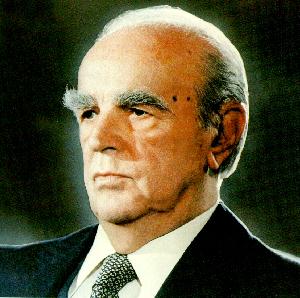Constantine Karamanlis
|
|
Constantine (Konstantinos) Karamanlis (Κωνσταντίνος Καραμανλής) (March 8, 1907 - April 23, 1998) was a Greek politician.
| Contents |
Early Life
He was born in the town of Proti, in the Serres Prefecture in northern Greece. His father was Georgios Karamanlis, a teacher who fought during the national struggle of the Greeks in Macedonia, in 1904-1908. After spending his childhood in Macedonia, he went to Athens to attain his degree in Law. He practiced law in Serres, entered politics with the conservative People's Party (Laikon Komma) and was elected Member of Parliament for the first time at the age of 28, in the last elections held before World War II.
First Premiership
After World War II, Karamanlis quickly rose through the ranks of Greek politics, eventually becoming Minister of Public Works for the Hellenikos Synagermos administration under Prime Minister Alexander Papagos. He performed unusually well in this position and, when Papagos died and was to be succeeded, King Paul of Greece immediately suggested the young Karamanlis for Prime Mininster. In doing this, the King bypassed Stephanos Stephanopoulos and Panagiotis Kanellopoulos, the two senior Synagermos politicians who were widely considered as the heavyweights most likely to succeed Papagos. Karamanlis first became prime minister in 1955, securing an absolute parliamentary majority in three successive elections (1955, 1958 and 1961). In 1959 he announced a five-year plan (196064) for the Greek economy, emphasizing improvement of agricultural and industrial production, heavy investment on infrastructure and the promotion of tourism. In the meantime he had refounded Papagos' old Synagermos party under a new name, "Ethnike Rizospastike Enosis" (National Radical Union).
Exile
In July 1963, he resigned the premiership after a disagreement with King Paul of Greece, probably fuelled by the intense antipathy Queen Frederika felt for him, and spent four months abroad. In the meantime the country was in turmoil following the assassination of Dr. Gregoris Lambrakis, a leftist member of Parliament, by right-wing extremists during a pro-peace demonstration in Thessaloniki. In November the National Radical Union (ERE), under his leadership, was defeated by Georgios Papandreou's Center Union party in the general election. Deeply disappointed, Karamanlis left Greece. He was succeeded by Panagiotis Kanellopoulos as the ERE leader. He spent the next 11 years in self-imposed exile in Paris, France.
Second Premiership
Throughout his exile in France, Karamanlis was a vocal opponent of the military junta that seized power in Greece in April 1967. After the fall of the Régime of the Colonels in July 1974, he returned to Athens on a French Presidency Lear Jet made available to him by President Valéry Giscard d'Estaing, a close personal friend, and became Prime Minister on a wave of huge public support, mainly because he was considered the best available solution. He formed a government of National Unity in order to deal immediately with the Cyprus crisis and to restore democratic institutions in Greece. He legalized the Communist Party of Greece (KKE) but he didn't immediately abolish censorship and appeared initially indulgent with members of the 1967 coup who still held on to positions of power in the police and armed forces.
Nevertheless his policy of democratization was gradual and steadfast, and eventually all remnants of the Régime of the Colonels were eliminated. He presided over several milestones in the democratization process, most notably the trial of the former dictators (who received death penalties for high treason and mutiny, mitigated to life incarceration), the staging of free parliamentary elections, the 1974 plebiscite on the abolition of the monarchy and the establishment of the Republic, the writing of the 1975 constitution and the implementation of Greece's accession into the European Economic Community.
In 1974, Karamanlis founded a new conservative party, New Democracy, won the 1974 and 1977 parliamentary elections, and served as Prime Minister until 1980, when he resigned following his signing of the EEC-Greece Accession Treaty. He was succeeded as Prime Minister by George Rallis.
First and Second Presidency
Karamanlis was elected President of the Republic by Parliament in 1980 and served until 1985. He oversaw Greece's entry (1981) into the European Community (now the European Union). In 1990 he was re-elected President by a conservative parliamentary majority (administration of Prime Minister Constantine Mitsotakis) and served until 1995, when he was succeeded by Costis Stephanopoulos.
Legacy
Karamanlis retired in 1995, at the age of 88, having won 5 parliamentary elections, and having spent 14 years as Prime Minister, 10 years as President of the Republic, and a total of more than sixty years in active politics. For his long service to democracy and the European cause Karamanlis was awarded the Karlspreis in 1978. He died after a short illness in 1998, at the age of 91. He bequeathed his archives to the "Constantine Karamanlis Foundation", a conservative think tank he had founded and endowed.
His nephew Costas Caramanlis is now the leader of the New Democracy party, and Prime Minister as of March 7, 2004.
See also
| Preceded by: Alexandros Papagos | Prime Minister of Greece 1955–1958 | Succeeded by: Constantine Georgakopoulos |
| Preceded by: Constantine Georgakopoulos | Prime Minister of Greece 1958–1961 | Succeeded by: Constantine Dovas |
| Preceded by: Constantine Dovas | Prime Minister of Greece 1961–1963 | Succeeded by: Panagiotis Pipinelis |
| Preceded by: Adamantios Androutsopoulos | Prime Minister of Greece 1974–1980 | Succeeded by: George Rallis |
| Preceded by: Constantine Tsatsos | President of Greece 1980–1985 | Succeeded by: Ioannis Alevras |
| Preceded by: Christos Sartzetakis | President of Greece 1990–1995 | Succeeded by: Kostis Stephanopoulos Template:End boxbg:Константинос Г. Караманлис de:Konstantinos Karamanlis nl:Konstantinos Karamanlis |

